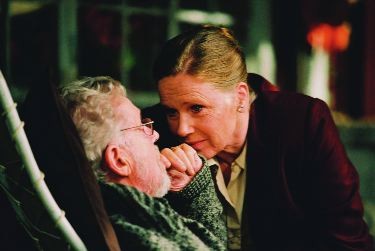Family fallout

For old-school cinephiles who bemoan the demise of the classical European art film, rife with misplaced passion and rampant guilt, a familiar name has come to the rescue. Ingmar Bergman, the Swedish writer-director who introduced a generation of American moviegoers to subtitled movies in the 1950s and 1960s with such influential films as The Seventh Seal, The Virgin Spring, Through a Glass Darkly and Persona (to name a few), has made what he says will be his last film. Produced for Swedish television in 2003, when Bergman was 85, Saraband is only now reaching American theaters. It’s a reminder of what genius can do regardless of age.
Bergman has referred to Saraband as an epilogue to his 1973 film Scenes from a Marriage, which first played on Swedish television and was later released in a shorter theatrical version for U.S. screens. (Both versions are on the Criterion Collection DVD.) It is an epilogue versus a sequel, because it quickly becomes clear that it is not going to be about the two protagonists of that first film, Marianne (Liv Ullmann) and Johan (Erland Josephson), even though these two screen legends take up the first part of Saraband.
Once we discover—through an initial monologue—that Marianne is visiting Johan for the first time in 30 years, and that Johan has inherited a great deal of money and now lives in relative solitude surrounded by his books, Bergman shifts the dramatic focus to the other two characters in this four-character movie. These are the two who have suffered much of the collateral damage from the original battle in Scenes from a Marriage: Henrik (Borje Ahlstedt), Johan’s 61-year-old son from an earlier marriage, and Karin (Julia Dufvenius), Henrik’s 19-year-old daughter.
With the introduction of these characters, the film immediately starts to take shape. The title of the film refers to an 18th-century royal dance for two that was later deemed too erotic and banned from many of the courts. It is the perfect metaphor for Bergman to employ here, as the film is a series of two-person dialogues among the four central players. These dialogues not only fit perfectly into place, but they build on each other, forming an ominous tower.
The dramatic star of the film turns out to be Henrik, a struggling musician who relies on his father for financial support. Ahlstedt has been a supporting actor in Bergman films for years, normally playing sad characters straight out of a Chekhov play. In Saraband he starts in that vein, but before long he shifts gears, and in a painful scene with Marianne (which takes place in a church) he makes clear just how much he despises his father. “I hate him in every dimension of the word,” he tells a stunned Marianne. “I hate him so much I’d happily watch him die of some horrible disease. I’d visit him daily and take note of his torment down to the last breath.”
Saraband tells us why there is such loathing among the characters, and it reveals how new problems develop, most notably between Henrik and Karin, a cellist with greater musical potential than her father. As Henrik broods over the many failures of his life, Karin is trying desperately to move forward with her career—with her clutching father draped over her back.
As the dialogues grow in intensity, we come to realize that there are two other characters of note in the film, both unseen except in a photograph and a chilling coda. The first is Anna, Henrik’s wife and Karin’s mother, who died of cancer. It is Henrik’s inability to accept her death that has led to his unhealthy relationship with Karin. Anna has also had an influence on Johan, who keeps a photograph of his dead daughter-in-law in his room, wondering aloud how such a woman could have been involved with a dolt like Henrik. (Suggestions of incest run through the film like the strains of Bach on the soundtrack.)
The other character is Martha, Marianne and Johan’s daughter, who lives in a mental institution. Once she makes her cameo appearance, it becomes clear that, among other things, Saraband is about parents who are so focused on their own success and happiness that they allow their children to be cast aside. It suggests that while many of Bergman’s characters, dating back to the ’50s, have been worried about the silence of God, the meaning of life or the nature of love and passion, their children have been quaking in the shadows.




